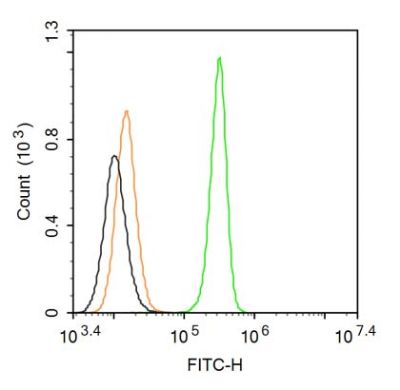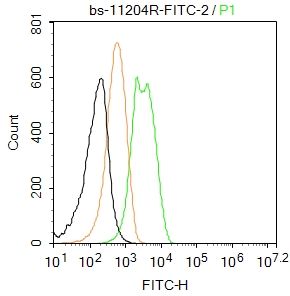background:
Pax genes contain paired domains with strong homology to genes in Drosophila which are involved in programming early development. The PAX2 gene is expressed in primitive cells of the kidney, ureter, eye, ear, and central nervous system. More specifically, in human embryo sections, PAX2 is expressed in the optic vesicle and later in the retina, in the otic vesicle and later in the semicircular canals of the inner ear, and in mesonephros, metanephros, adrenals, spinal cord, and hindbrain. PAX2 mutations can be responsible for renal hypoplasia, either isolated or associated with various ophthalmologic manifestations ranging from retinal coloboma to microphthalmia. The gene which encodes Pax-2 maps to human chromosome 10q24.3-q25.1. Lesions in the PAX6 gene accounts for most cases of aniridia, a congenital malformation of the eye, chiefly characterized by iris hypoplasia, which can cause blindness. PAX6 is involved in other anterior segment malformations besides aniridia, such as Peters anomaly, a major error in the embryonic development of the eye with corneal clouding with variable iridolenticulocorneal adhesions. The gene which encodes Pax-6 maps to human chromosome 11p13.
Function:
Transcription factor with important functions in the development of the eye, nose, central nervous system and pancreas. Required for the differentiation of pancreatic islet alpha cells (By similarity). Competes with PAX4 in binding to a common element in the glucagon, insulin and somatostatin promoters. Regulates specification of the ventral neuron subtypes by establishing the correct progenitor domains (By similarity). Isoform 5a appears to function as a molecular switch that specifies target genes.
Subunit:
Interacts with MAF and MAFB (By similarity). Interacts with TRIM11; this interaction leads to ubiquitination and proteasomal degradation, as well as inhibition of transactivation, possibly in part by preventing PAX6 binding to consensus DNA sequences.
Subcellular Location:
Nucleus.
Tissue Specificity:
Fetal eye, brain, spinal cord and olfactory epithelium. Isoform 5a is less abundant than the PAX6 shorter form.
Post-translational modifications:
Ubiquitinated by TRIM11, leading to ubiquitination and proteasomal degradation.
DISEASE:
Defects in PAX6 are the cause of aniridia (AN) [MIM:106210]. A congenital, bilateral, panocular disorder characterized by complete absence of the iris or extreme iris hypoplasia. Aniridia is not just an isolated defect in iris development but it is associated with macular and optic nerve hypoplasia, cataract, corneal changes, nystagmus. Visual acuity is generally low but is unrelated to the degree of iris hypoplasia. Glaucoma is a secondary problem causing additional visual loss over time.
Defects in PAX6 are a cause of Peters anomaly (PAN) [MIM:604229]. Peters anomaly consists of a central corneal leukoma, absence of the posterior corneal stroma and Descemet membrane, and a variable degree of iris and lenticular attachments to the central aspect of the posterior cornea.
Defects in PAX6 are a cause of foveal hypoplasia (FOVHYP) [MIM:136520]. Foveal hypoplasia can be isolated or associated with presenile cataract. Inheritance is autosomal dominant.
Defects in PAX6 are a cause of keratitis hereditary (KERH) [MIM:148190]. An ocular disorder characterized by corneal opacification, recurrent stromal keratitis and vascularization.
Defects in PAX6 are a cause of coloboma of iris choroid and retina (COI) [MIM:120200]; also known as uveoretinal coloboma. Ocular colobomas are a set of malformations resulting from abnormal morphogenesis of the optic cup and stalk, and the fusion of the fetal fissure (optic fissure). Severe colobomatous malformations may cause as much as 10% of the childhood blindness. The clinical presentation of ocular coloboma is variable. Some individuals may present with minimal defects in the anterior iris leaf without other ocular defects. More complex malformations create a combination of iris, uveoretinal and/or optic nerve defects without or with microphthalmia or even anophthalmia.
Defects in PAX6 are a cause of coloboma of optic nerve (COLON) [MIM:120430].
Defects in PAX6 are a cause of bilateral optic nerve hypoplasia (BONH) [MIM:165550]; also known as bilateral optic nerve aplasia. A congenital anomaly in which the optic disc appears abnormally small. It may be an isolated finding or part of a spectrum of anatomic and functional abnormalities that includes partial or complete agenesis of the septum pellucidum, other midline brain defects, cerebral anomalies, pituitary dysfunction, and structural abnormalities of the pituitary.
Defects in PAX6 are a cause of aniridia cerebellar ataxia and mental deficiency (ACAMD) [MIM:206700]; also known as Gillespie syndrome. A rare condition consisting of partial rudimentary iris, cerebellar impairment of the ability to perform coordinated voluntary movements, and mental retardation.
Similarity:
Belongs to the paired homeobox family.
Contains 1 homeobox DNA-binding domain.
Contains 1 paired domain.
Database links:
Entrez Gene: 395943 Chicken
Entrez Gene: 286857 Cow
Entrez Gene: 5080 Human
Entrez Gene: 18508 Mouse
Entrez Gene: 25509 Rat
Entrez Gene: 30567 Zebrafish
Omim: 607108 Human
SwissProt: P47237 Chicken
SwissProt: Q1LZF1 Cow
SwissProt: P26367 Human
SwissProt: P63015 Mouse
SwissProt: P63016 Rat
SwissProt: P55864 Xenopus laevis
SwissProt: P26630 Zebrafish
Unigene: 270303 Human
Unigene: 611376 Human
Unigene: 33870 Mouse
Unigene: 728 Mouse
Unigene: 89724 Rat
Unigene: 647 Xenopus laevis
Unigene: 24244 Zebrafish
Important Note:
This product as supplied is intended for research use only, not for use in human, therapeutic or diagnostic applications.
| Picture |
Blank control (Black line): HeLa (Black).
Primary Antibody (green line): Rabbit Anti-PAX6/FITC Conjugated antibody (SL11204R-FITC) ,Dilution: 1μg /10^6 cells;
Isotype Control Antibody (orange line): Rabbit IgG/FITC (SL0295P-FITC).Dilution: 1μg /test.
Protocol
The cells were fixed with 4% PFA (10min at room temperature)and then permeabilized with 90% ice-cold methanol for 20 min at room temperature. The cells were then incubated in 5%BSA to block non-specific protein-protein interactions for 30 min at room temperature .Cells stained with Primary Antibody for 30 min at room temperature.Acquisition of 20,000 events was performed.
Blank control:Hela.
Primary Antibody (green line): Rabbit Anti-PAX6 antibody (SL11204R-FITC)
Dilution: 2μg /10^6 cells;
Isotype Control Antibody (orange line): Rabbit IgG .
Protocol
The cells were fixed with 4% PFA (10min at room temperature)and then permeabilized with 90% ice-cold methanol for 20 min at-20℃. The cells were then incubated in 5%BSA to block non-specific protein-protein interactions for 30 min at room temperature .Cells stained with Primary Antibody for 30 min at room temperature. Acquisition of 20,000 events was performed.
|
|
|

